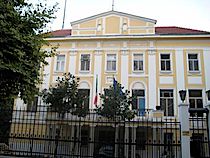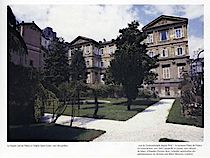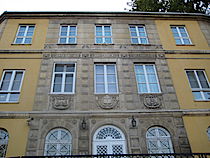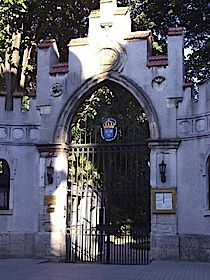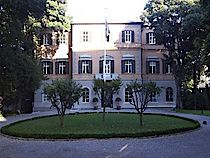II. In the Sultan's Capital
1. Three Ambassadors' Performances in Constantinople
a. 1524 The Earliest Ballet
1st Interlude / The First Turkish Themes On European Stages
b. 1665 A Performance by the Capuchins-Palais de France
2nd Interlude / Continuing Turqueries
c. 1786 The First Opera Performance- Palais de Suède
3rd Interlude/Ottoman-Habsburg Junctions Through the End of a Century
2. Sultan Selim III-Diplomatic Reforms and Opera at the Ottoman Court
a. Artist in Own Right
b. Diplomatic Reforms
3. Opera, Ottomans and Diplomats: Highlights
b. Abdülmecid (r.1839-1861)
c. Abdülhamid II (r.1876-1909)
This is where we take a close look at the relation of opera and diplomacy in Istanbul. The following three parts compose a summary of the history of opera in Ottoman Empire. The first of them brings together the earliest performances relevant to diplomacy in Ottoman history; the second one portrays the age of Sultan Selim III (1761/1789-1807/1808) and contextualizes Ottomans reception of opera with Selim III and the diplomacy in his era, and finally the third part sums up the linkages of Ottomans and opera.
1. Three Ambassadors' Performances in Constantinople
1524-1665-1786
The three events which follow are significant and focal for our research interests; because they feature the firsts which we have come to find out so far: the first ballet performance, the first drama performance in the French Embassy, and the first opera performance in Ottoman Istanbul.
The history of western performing arts in the Ottoman life covers a rather surprising time-span: from as early as 16th to 19th Centuries. Throughout this lengthy period, diplomatic corps enjoy an influential role. The initial encounters of Ottoman envoys in European Capitals as they were sent on mission in 18th Century constitute the introduction of this art form to the Ottoman society, and their ambassadorial reports and chronicles provide the initiatory evidential documents.
a. 1524 The Earliest Ballet Performance
Metin And (1927-2008), doyen of performing arts studies in Turkish and internationally acclaimed performing arts historian, in his work The Italian Stage in Turkey, Turkey on the Italian Stage (Metis Publ. 1989) which, being published in both Turkish and Italian, remains an indispensable reference for Turkish theatre/opera researchers, gives us an account of a finding he encountered in a study on ballet history published in France by Ferdinando Reyna, Des Origines du Ballet, Paris 1955, p. 91).
« En 1524, à Constantinople, la colonie vénitienne fit régler un étrange ballet : une jeune fille très belle, prisonnière de deux vieillards, invoquait désespérément la Mort : en dansant elle exprimait tout cela par le geste. Et la Mort venait, elle la touchait de sa faulx ; les vêtements de la jeune fille tombaient et elle restait nue, morte, enveloppée dans ses cheveux d'or. »
As And also mentions, Reyna unfortunately does not provide the original source for this unique information.
1st Interlude / The First Turkish Themes On European Stages
Turkish themes appear rather often in various repertoires and periods in theatrical history. One example is the compilation titled "Sultans on Opera Stage", studied by Johannes Schweitzer. From Catalogo analitico "I Libretti Italiani a Stampa dalle Origini al 1800" of Claudio Sartori (Cuneo 1994), Schweitzer compiled the Italian libretto prints that bring out a "Sultan" as subject and cast. This study of Schweitzer introduces stage works with the following Sultans/Sultan figures: Osmano (Osman), Bajazet (Beyazit), Amurat II. (Murat II), Memete II.(Mehmet II), Solimano I. & II. (Süleyman I & II), Ibrahim, Selim I. & II. Another example to the first Turkish themes on European Stages is provided by Stephan Schmuck, in his essay "From Sermon to Play: Literary Representations of 'Turks' in Renaissance England 1550-1625". The essay investigates the figure of 'Turks' in English literary and dramatic texts. One of the earliest of such is that of John Fox, titled The Worthy Enterprise of John Fox, in Delivering 266 Christians Out of the Captivity of the Turks, and is dated back to 1579. There is in fact vast bibliographical material on Turkish themes in European art. Michael Hüttler has conducted two bibliographical studies on literature collection of opera / travel / cultural exchange between Habsburg Monarchy and Ottoman Empire in 18th Century as well as of Turkish themes in the opera and drama of the 17th and 18th Centuries.
b. 1665 A Performance by the Capuchins-Palais de France
Acclaimed Austrian theatre scholar Walter Puchner, renowned for his research on 17th century religious and barock drama, in his latest article to be published in the coming volume of Don Juan Archiv Wien « European Drama and Theatre in Seventeenth-Century Istanbul », shares with the reader an astoundingly essential discovery; a drama performance in the French Embassy in 1665, evidently the first performance known to be realized in the French Embassy in Istanbul:
« There is evidence of a theatrical production by the capuchins in Galata, Constantinople, in a document of 1665. Unlike the Jesuit plays, the event did not happen in the church, but in the French Embassy. (...) The Capuchins performed the religious drama Le Baptesme de Saint Genest, an adaptation of Jean Rotrou's (1609-1650) tragedy about the story of the mime-martyr. (...) The central role in this St. Genesius play, the Roman Emperor Gaius Aurelius Valerius Diocletianus, was played by the son of the chargé d'affaires of the French embassy, François Roboly (d. 1689). The performance was very successful, there were crowds of spectators, and the chargé announced that if they wished to stage another tragedy he would be the sponsor. »
2nd Interlude / Continuing Turqueries
The five-act comédie-ballet by Molière (1622-1673) and Jean-Baptiste Lully (1632-1687) titled Le Bourgeois Gentilhomme (The Bourgeois Gentleman) which was first staged on October 14, 1670, reflected the European fashion, or tendency of les turqueries which was en vogue in Europe in the 18th century. The work stemmed from the diplomatic scandal caused by the Sultan Mehmed IV's envoy Süleyman Aga (Müteferrika Süleyman) who, upon visiting the court of Louis XIV in 1669, affirmed the superiority of the Ottoman court to the French. The ambassadorial report by Yirmisekiz Çelebi Mehmet Efendi, the most prominent Ottoman envoy of Sultan Ahmed III (r. 1703-1730) to Paris (1720-1721) is the earliest source which informs the Ottoman world about "opera", and where "opera" is initially mentioned. The Ottoman envoy of Sultan Mahmud I (r. 1730-1754) , Mustafa Hatti Efendi (~1680 - ~1760) who was sent on a mission to Vienna in 1748 attended operas there. These spectacles were as follows: on July 14th La Diana oder Le pazzie di Diana, (composer unknown), July 17th Alessandro nell' Indie by Georg Christoph Wagenseil (1715-1777), and on July 29th of 1748, Mustafa Hatti attended the performance of a German comedy (Deutsche Komödie). Another opera that Mustafa Hatti watched on August 20th was Orazio by Giovanni Battista Pergolesi (1710-1736).
In 18th century opera, the Turqueries are embodied and culminated quintessentially in W.A. Mozart's (1756-1791) Die Entführung aus dem Seraglio (1782) and Zaide (1780) as well as in works of Haydn (1732-1809) i.e. L'Incontro Improviviso (1775), and in works of C.W. Gluck (1714-1787) i.e. Le cadi dupe (1761) or La rencontre imprévue (1764) a.k.a. The Pilgrim of Mecca.
c. 1786 The First Opera Performance- Palais de Suède
The earliest given opera performance in Istanbul is recorded to have taken place in the year 1786 - for Vienna the year of Nozze di Figaro (Da Ponte/Mozart, May 1st) and Cosa rara (Da Ponte/Martini, November 17th) - and on the date of February 22nd in the Swedish Embassy, by the then Swedish Ambassador Hrn. Von Haydenstamm. It is recorded to have been an Italian opera piece with the embassy deputies themselves appearing in the roles of stand-ins. Interestingly enough, the Ambassador himself had not only composed the opera, but also had he conducted the orchestra (Magazin der Musik. Herausgegeben | von | Carl Friedrich Cramer, | Professor in Kiel. | Zweyter Jahrgang. | Zweyte Hälfte. | 1786. | Hamburg | in der Musicalischen Niederlage).
« Den 21sten November, 1786. | Nachrichten. Auszüge aus Briefen. » (pp. 915-991), darin pp. 956-957:
« 14) Aus einem Schreiben aus Pera, vom 17ten März, 1786. ) In dem Hotel des allhier residirenden Königl. Schwedis. Gesandten, Hrn. von Haydenstamm, war am 22sten Febr. die sehr seltene Fette der öffentlichen Vorstellung einer italiänischen Oper, wobey die Rolle bloß von Standespersonen von den Gesandtschaften gespielt wurden. Die Frau von Haydenstamm und die Tochter des Spanis. Gesandten, Hrn. von Bouligny, spielten die ersten Damen=Rollen; der Spanis. Gesandte selbst, der Venetianis. Gesandschafts=Cavalier Barbarini und die Hrn. Ristorini und Bianchi spielten die vornehmsten Rollen; die Soubrette wurde von einer gebornen Constantinopolitanerin, Sophia Michel vorgestellt. Der Schwedis. Gesandte selbst hatte die Oper componirt, und dirigirte das [pag. 957] Orchester, der Kayserl. Dollmetscher, Hr. von Raab, war Theatermeister, und der Italiänis. Cavalier Calogera, Soufleur. Alle hier residirende Standespersonen, und selbst viele vornehme Türken, waren gegenwärtig. »
3rd Interlude / Ottoman-Habsburg Junctions Through the End of a Century
In the works of Turkish authors, this is regarded as the first encounter with opera until 1797, when Selim III would invite an Italian opera troupe (from Pera) to Topkapi.
Tarare in Paris / Axur in Vienna: Axur re d'Ormus, the dramma tragicomico by Lorenzo Da Ponte and Salieri premiered in 1788 in Vienna, and this work signals the collaboration of Da Ponte with Salieri in 1787. Axur is actually an Italian version of the opera Tarare, which premiered on 8th June 1787 in Paris with a huge success. Salieri largely composed the opera anew. Tarare, the five-act opera of Salieri, premiered in 1787 in Paris.
In the year 1791, Ebubekir Ratip Efendi (1749-1799) was posted as envoy to Vienna by Selim III, and set off for his journey on 9th November 1791. On the way to Vienna, as he and his retinue arrives in Temesvar on January 11th 1792 to make a stopover for four days, he attended an opera (a tragedy). The research for exact data on this opera evening is in continuation.
2. Sultan Selim III - Diplomatic Reforms and Opera at the Ottoman Court
In the eighteenth century, the age of Sultan Selim III (r.1789-1807) is simply a remarkable one. And certainly one closely related to opera and diplomacy. What makes him and his age noteworthy is firstly his reformist character which is embodied in his institution of essential military, diplomatic and social reforms; and secondly his affinity to arts and his own artistry.
a. Artist in Own Right
Selim III was a versatile artist: a talented and productive composer, a poet, and a patron of arts: internationally acclaimed Turkish art historian Günsel Renda analyzes Selim's III patronage in Ottoman art in her latest article "Sultan Selim III as a Patron of Arts" to be published in the coming volume of Don Juan Archiv Wien:
« The reign of Sultan Selim III marks a turning point in Ottoman painting. Royal patronage took a new form and imperial portraiture was an important factor in the adoption of European style painting in the Empire. Sultan Selim's patronage resulted in the production of a great number of oil paintings not only portraits but also ceremonial scenes revealing his interest in new media, new techniques and new functions of painting. »
He usually retired to his own « Composition Chamber » in Aynalikavak Pavillion, which was an oase of inspiration for his music.
As composer, he created 16 different musical modes (makams), has 108 compositions known to us, 40 of which are songs and 6 religious hymns. He also was a prolific poet and wrote under the pseudonym Ilhami, and collected his poems in six diwans.
b. Diplomatic Reforms
The fundamental reform of Selim III in diplomacy is his establishment of the first Ottoman resident embassies in the key Capitals of Europe: London (October 1793), Berlin (June 1795), Vienna (September 1795) and Paris (September 1796). This led to a profound change in Ottoman diplomacy.
c. Opera at the Court
Selim III was a music enthusiast, also of European music. He was the first Sultan to introduce european stage art to the Ottoman Court: on 15th May of the year 1793, he attended in Topkapi to what is regarded a European ballet performance, Frenk Rakkaslari (European dancers) as named and recorded by his chronicler Ahmed Efendi. He invited (3rd May) in 1797 an (Italian) opera troupe to Topkapi. This is known in Ottoman History as the first opera at the court. Selim's III chronicler Ahmed Efendi reports of this occasion in his Rûzname, which could be defined as the imperial diary covering Selim's III daily activities during the years 1791-1802.
3. Opera, Ottomans and Diplomats: Highlights
The history of western performing arts in the Ottoman life covers a rather surprising time-span: from as early as 16th to 19th Centuries. Throughout this lengthy period, diplomatic corps enjoy an influential role. The initial encounters of Ottoman envoys in European Capitals as they were sent on mission in 18th Century constitute the introduction of this art form to the Ottoman society, and their ambassadorial reports and chronicles provide the initiatory evidential documents. The ambassadorial report by Yirmisekiz Çelebi Mehmet Efendi, the most prominent Ottoman envoy of Sultan Ahmed III (r. 1703-1730) to Paris (1720-1721) is the earliest source which informs the Ottoman world about "opera", and where "opera" is initially mentioned.
These ambassadorial reports/chronicles may also be said to have functioned as means of motivation for the Ottoman Sultans to establish their own court theatres [app. 140 years later]: the first of such is the Dolmabahçe Court Theatre established in 1859 by Sultan Abdülmecid (1823/1839-1861) and the second is the Yıldız Court Theatre established 1889 by of Sultan Abdülhamid II ( 1842/1876-1909).
Selim III (r. 1789-1807), Mahmud II (r. 1808-1839), Abdülmecid (r. 1839-1861) and Abdülhamid II (r.1876-1909) are the four Sultans who were renowned opera enthusiasts to be engaged in this art form.
With 18th Century witnessing mostly Ottoman envoys' opera experiences in European Capitals, in 19th Century the Ottoman Capital becomes vibrantly and frequently engaged in opera: The following three Sultan eras and a few noteworthy examples within will explain:
a. Mahmud II (r.1808-1839)
During his reign, the interest in theatre and dramatic arts grew. It is also in his period and with his initiative that in 1828 Giuseppe Donizetti came to Istanbul to establish a military band. Metin And conveys us the information from a French magazine "Revue du Theatre, 1836 / VII", which reports that Mahmud II "in 1836 ordered for the Court library 500 theatre texts; of them 40 tragedies, 50 dramas, 30 comedies and 280 vaudevilles" (And 1989: 25).
b. Abdülmecid (r.1839-1861)
The first libretto published in Ottoman-Turkish is Gaetano Donizetti's Belisario (Libretto by Salvatore Cammarano; Venice carneval of February 1836) which was performed in the 1841/42 season in the Naum Theatre in Pera: this is the diplomatic quarter of Konstantiniyye; The Turkish name of Pera, Beyoğlu, comes originally from the Turkicized form of Bailo, which stands for the Venetian Ambassador in Konstantiniyye. The Bailo's residence was the most grandiose structure in this quarter, the Il Palazzo Venezia. The name originates from Bey Oğlu (literally Son of Governor) and was particularly used by the Turks to describe Alvise Luigi Giritti, son of Andrea Giritti (1503), the Venetian Bailo during the reign of Süleyman the Magnificent (r. 1520-66). With the conquest of Constantinople in 1453 the European presence in Pera did not end. During 17th, 18th and 19th centuries it was again home to many European embassies, especially along the Grande Rue de Péra (today Istiklal Avenue). Verdi's Il Trovatore (Libretto by Salvatore Cammarano; Rome, January 1853) was staged in the same year in the Naum Theatre even before its French debut performance in Paris (1857).
First Libretto in Ottoman Turkish and an Ambassador: The first stage piece written in Ottoman Turkish is a libretto, with Sevengil's words an "opera livre", and written by Hayrullah Efendi (1817-1866), a physician of the Tanzimat Period (Reformation 1839-1876), one of the prominent officials of the Tanzimat Period and a historian, who also was an ambassador to Persia (1865-1866). The libretto is titled Hikâye-i Ibrahim Paşa be-Ibrahim-i Gülşenî (The Story of Ibrahim Pasha and Ibrahim Gülşenî), and was written around 1844, only two years after the translation to Ottoman Turkish of the libretto of Belisario in 1842. Hikâye-i Ibrahim Paşa be-Ibrahim-i Gülşenî was neither staged nor printed. (Sevengil 1969:69)
Bosco Theatre (1840-1844) and Naum Theatres (1844-47 and 1848-1870): The theatre that the Italian illusionist Giovanni Bartolomeo Bosco founded in Beyoglu in 1840 was the basis for the Naum Theatre to follow, which was the "home" of Italian opera and theatre (And 1989: 31). Mihail Naum undertook the theatre and founded his Naum Theatre, which was an important époque in the theatre of Tanzimat Period, and which served the dispersion of opera-going for 25 years. Mihail Naum renovated the theatre and opened it in 1844: Lucrezia Borgia was the first opera to be performed (29th December 1844) by the Italian actors commissioned by Naum (Sevengil 1969:26). Naum's first theatre burned down in the 1846 Beyoglu Fire, which led Naum to rebuild his theatre anew, this time with support from foreign embassies, and also from the Sultan. The second Naum Theatre premiered with Macbeth on 4th October 1848 (Sevengil 1969:29).
Dolmabahçe Court Theatre: Sultan Abdülmecid established the first Imperial theatre of the Ottoman Court in opposite of the Dolmabahçe Palace in 1859. According to Sevengil, one of the major reasons might have been the Sultan's wish "that the Ottoman Court should not be lesser glamorous than the European Courts"; an Imperial theatre to be established not only would "enrich the Ottoman Sultan's Court, but also this would help the dispersion of opera and theatre". Sevengil underlines that Dolmabahçe Court Theatre was the first theatre house built by the Imperial state; the second would be built in Bursa (1879), and the third in the same year in Adana (Sevengil 1962:19).
c. Abdülhamid II (r.1876-1909)
Yıldız Court Theatre: The second court theatre was established by Sultan Abdülhamid II in 1889. Sevengil provides detailed description and data on this second Ottoman court theatre: It was built in the area of the Yıldız Palace where Abdülhamid II preferred to spend his years. The Sultan hosted the German Emperor Wilhelm II in the Yıldız Palace Theatre in 1889. It was customary to include an opera evening in the protocol program during the state official visits of the foreign heads of state. During Abdülaziz' reign, opera evenings in the Naum Theare served to this custom; whereas during the reign of Abdülhamid II, members of foreign ruling dynasties were continually invited to Yıldız Court Theatre. Abdülhamid II also established an opera/operette ensemble composed of Italian artists, which, beginning with 1892-93 season, performed regularly for fifteen years. Sevengil quotes Ayşe Osmanoglu, Abdülhamid II's daughter, who in her memoirs tells that the most frequently performed works were "Traviata, Troubadour, Bal Masqué, Barbier de Seville, La Fille de Regiment, Fra diavolo, Mascotte and La Belle Hellene. These operas were named differently in the Court" (Sevengil 1962:122) as follows:
[La] Traviata - Madam Kamelya
[The] Troubadour - Demirci Operası (the Blacksmith's Opera)
Barbier de Seville - Berber Operası (Barber's Opera)
Bal Masqué - Maskeli Opera (The Masked Opera)
Fra diavolo - Haydut Operası (The Bandit's Opera)
La Fille de Regiment - Asker Kız Operası (The Soldier Girl's Opera)
La Belle Hellene - Çoban Operası (Shepherd's Opera)
Rigoletto - Kral Kız Operası (King Girl's Opera)
Mascotte - Maskot
[Continue III. Further Prospectives]
[Don Juan]
["Fuerza al Turco"]
